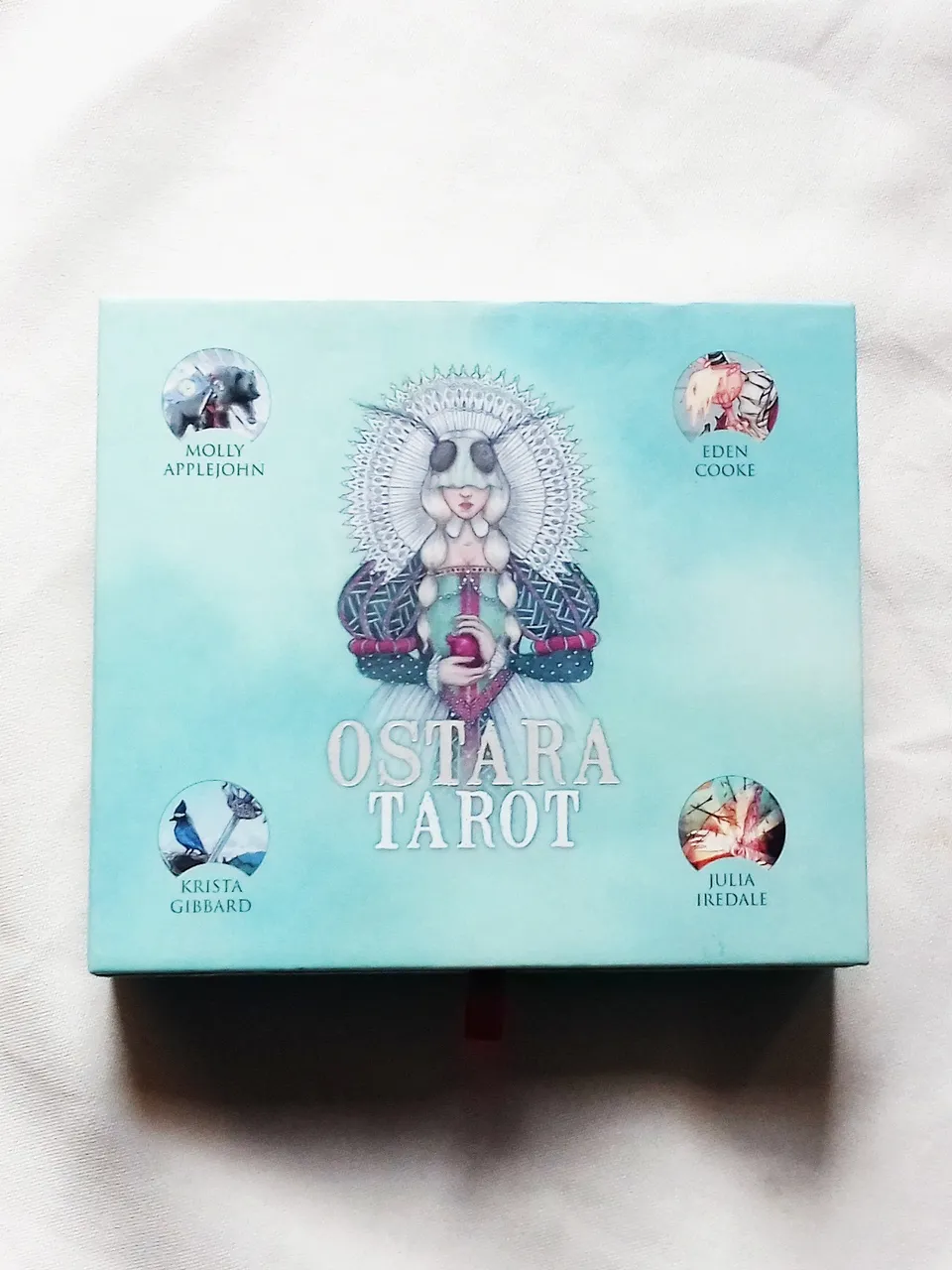
So, I recently got a number of new tarot and oracle decks, and as I’ve always wanted to make some deck “showcases” to talk about my experiences with and thoughts on them, I think there’s no better time to do it than now :3
Recientemente recibí algunos mazos de Tarot y Oráculos nuevos, y como siempre me ha gustado hacer pequeñas “reseñas” para hablar sobre mis experiencias y opiniones al respecto, pensé que seria una buena oportunidad para hacerlo :3
So, I’ll start with a deck that has quickly won me over in every regard: the Ostara Tarot!
Así que comenzare con una baraja que rápidamente se ha vuelto de mis favoritas: ¡El Tarot Ostara!
The term “it takes a village to raise a kid” can be easily applied to Tarot decks: while there are obviously decks made by a single person as thinker and artist, most of them tend to be collaborative efforts, with one part being the intellectual originator of the concept and the other the artist that brings the idea to life; with the most high profile example of this being the very deck that popularized Tarot and where most of its modern symbolism can be traced to, the Rider Waite Smith deck, conceived by Arthur Edward Waite, illustrated by Pamela Coleman Smith and printed by the Rider imprint.
La expresión “se necesita a una aldea para criar a un niño” puede aplicarse fácilmente a los mazos de Tarot: aunque hay mazos que son hechos por una sola persona como planificador y artista, la gran mayoría son esfuerzos colaborativos en que una parte toma el papel de originador intelectual del concepto, y la otra siendo el artista (o artistas) que plasma esa visión; siendo el ejemplo mas notorio de esto la baraja que popularizo al Tarot en primer lugar y de la que muchas creaciones modernas toman su simbolismo, el Tarot Rider Waite Smith, concebido por Arthur Edward Waite, ilustrado por Pamela Coleman “Pixie” Smith e impreso por la imprenta Rider.
The Ostara Tarot is also a collaborative effort, except that it is a very different take on such concept, as it isds the brainchild of four different illustrators: Molly Applejohn, Julia Iredale, Krista Gibbard and Eden Cooke. Each of these co-creatrixes takes on a suit of the Minor Arcana and a number of cards among the Major Arcana, their different styles blending into a coherent whole by exploring shared motifs with their own exclusive take; effectively creating a deck as varied and whimsical as it is beautiful. You can easily recognize each artist’s style and point of view in the cards, and it fits perfectly with the themes they explore.
El Tarot Ostara es también un trabajo colaborativo, excepto que toma un giro muy distinto a este concepto, siendo la creación de cuatro ilustradoras diferentes: Molly Applejohn, Julia Iredale, Krista Gibbard y Eden Cooke. Cada una de esta co-creadoras ilustra uno de los palos de los Arcanos Menores, asi como un numero de cartas de los Arcanos Mayores, sus diferentes estilos mezclándose en un todo coherente al explorar temas compartidos con su propia forma exclusiva de interpretarlos; efectivamente creando una baraja tan variada y caprichosa como es hermosa. Fácilmente puedes reconocer el estilo de cada artista y su punto de vista en las cartas, y encaja perfectamente con el significado de la misma.
Two words I’d use to define this deck are “Young” and “Feminine”: on the one hand, this deck has such vigor and energy that it immediately calls to mind youthful vitality like a child with the world as their playground, a young warrior marching up for battle, a nymph dancing in the woods; on the other, every color, shape and detail conveys a notion of the Divine Feminine. Both of these aspects pertain to “Ostara”, the Spring/Vernal Equinox, serving as a metaphor through which the deck embodies the renewal of life, highlighted by the presence of animals coming back from their hibernation (and there is a strong animal theme on this deck) and nature returning to its fertile cycle. There are also allegations claiming the name “Ostara” may come from a Germanic pagan Goddess (Eostre) whose festival was celebrated in the days corresponding to the end of March and the beginning of April and was eventually superseded/christianized into what we known today as Easter, with some elements more pertaining to its fertility nature coming through (the eggs, the rabbit); thus adding a whole layer into this youthful feminine energy that the deck emanate. This, to me, is one of the main charms of the deck: how vibrant and alive you feel when you read with it, how the Divine Feminine impregnates every little aspect of the deck. Thus, while its symbolism is not exactly the same as most decks, I definitely consider it a perfect deck for those still starting; especially for younger people (teenagers and young adults) who want a more dynamic deck, one that isn’t afraid to be whimsical and romantic and yet still presents the transcendental arcane knowledge of Tarot.
Dos palabras que usaría para definir esta baraja son “Joven” y “Femenina”: por un lado, este mazo tiene un vigor y energías que inmediatamente hacen pensar la vitalidad juvenil de un niño con el mundo como su terreno de juego, una joven guerrera marchando al campo de batallas, una ninfa bailando en los bosques; en la otra, cada colar, forma y detalle conlleva la noción de la Divinidad Femenina. Ambos aspectos son alusivos a “Ostara”, el Equinoccio Vernal o de Primavera, sirviendo como metáfora a través del cual el mazo encarna el renacer de la vida, marcado con la presencia de animales que salen de su hibernación (y hay una temática animal fuerte en este mazo) y la naturaleza volviendo a su ciclo fértil. Hay también alegatos que claman que el nombre Ostara puede estar derivado del de una Diosa pagana germánica (Eostre) cuyo festival seria celebrado entre lo que era el final de Marzo y el principio de Abril, y que fue eventualmente reemplazado o cristianizado con los elementos de lo que conocemos hoy como la Pascua, reteniendo en países angloparlantes y teutones algunos de los elementos paganos (como el Conejo de Pascua y los huevos, símbolos de fertilidad); añadiendo aun mas detalle a esta energía femenina juvenil que este mazo emana. Esto, para mi, es uno de los encantos de este Tarot: lo vibrante y vivo que se siente cuando lees con el, como la Divinidad Femenina impregna cada pequeño aspecto de este. Por ende, aunque el simbolismo no sea exactamente como el de la mayoría de los Tarots convencionales, definitivamente lo considero perfecto para quienes están empezando a estudiarlo; especialmente para adolescentes y jóvenes adultos que prefieran una baraja mas dinámica, que no tenga miedo de ser cómica o romántica a veces, y que aun así presente el conocimiento trascendental y arcano del Tarot.
Thus, to me, this deck feels like a spunky young woman with a charming disposition: the one who dances barefoot by herself with a flower crown in her head and subtle look in her eyes that gives away she knows more than she lets on without betraying WHAT she knows.
Por ello, para mi, esta baraja habla como si fuese una joven muchacha con una disposición encantadora: la que baila descalza a su propio ritmo con una corona de flores en su cabeza y dando miradas sutiles que dejan entrever que sabe mas de lo que dice, sin revelar QUE es lo que sabe.
Now, getting away from the background and into the deck itself, let’s start with something I love: THE SIGNATURE COLOR. By which I mean, this cloudy, minty green with slightly darker spots that dominates the box, Little White Book and back of every card, and which predominates in the color scheme for the High Priestess. Given the High Priestess is the card depicted in the box and LWB and the thematic motifs it has (which I’ll explain later), it feels so fitting, and reassures this is a deck full of feminine energy.
Ahora, saliéndome un poco del trasfondo y entrando en lo que es el mazo como tal, empecemos con algo que me encanta: EL COLOR QUE USAN PARA TODO. Con ello me refiero a esta mezcla nebulosa de tonalidades de verde menta que se aprecia en la caja, el Pequeño Libro Blanco y la parte de atrás de todas las cartas, además de ser el esquema de colores que predomina en la carta de la Suma Sacerdotisa. Dada que la Suma Sacerdotisa es la carta que se muestra en la caja y PLB, y los motivos temáticos que presenta (que explicare después), tiene muy buena congruencia con el todo y denota como este mazo esta lleno de energía femenina.

The box itself is gorgeous and coquettish in my opinion; this little green box with the High Priestess on the upper lid surrounded by four little circles featuring some of the art of the Minor Arcana and the name of the corresponding creator, and a small crimson ribbon loop to help open it up. On the front side of the box is the title “Ostara Tarot”; on each side the words “Ostara” and “Tarot” on the left and right sides respectively (with the Red Feather logo on the right side as well) and info on the publisher, copyright, printing and pricing on the back. The bottom half of the box has the image of the Knight of Wands in a small circular window, and a few words prefacing the deck and what it depict. Once you open it (the box being shut with magnetic clasps, by the way), the upper lid has little drawn portraits of the four creators of the deck along with a small paragraph talking succinctly about how they met, their interests and inspirations, and their accomplishments and endeavors; it also stays up in place thanks to two ribbons hinges.
La caja misma es hermosa y bastante coqueta en mi opinión; es esta pequeña cajita verde con la Suma Sacerdotisa en la cubierta superior rodeada de cuatro círculos que muestra un ejemplo del arte de los Arcanos Menores y el nombre de la creadora correspondiente, además de un pequeño bucle de tela roja para ayudar a abrirla. Por el frente de la caja esta el Titulo “Ostara Tarot”; en cada lado las palabras “Ostara” y “Tarot” (en el lado izquierdo y derecho, respectivamente, con el logo de RedFeather en el lado derecho también), y la información de la imprenta, derechos de autor, impresión y precio en la parte de atrás. En la parte de debajo de la caja esta la imagen del Caballero de Bastos en una ventanilla circular y una leyenda que sirven de prefacio para la baraja y lo que muestra. Una vez que la abres (la caja manteniéndose cerrada por medio de pernos magnéticos, por cierto), la tapa superior tiene pequeños retratos ilustrados de las cuatro creadoras del mazo junto con un párrafo detallando sucintamente como se conocieron, sus intereses e inspiraciones, así como sus logros y proyectos; y esta se mantiene en su sitio gracias a dos lazos de tela roja.
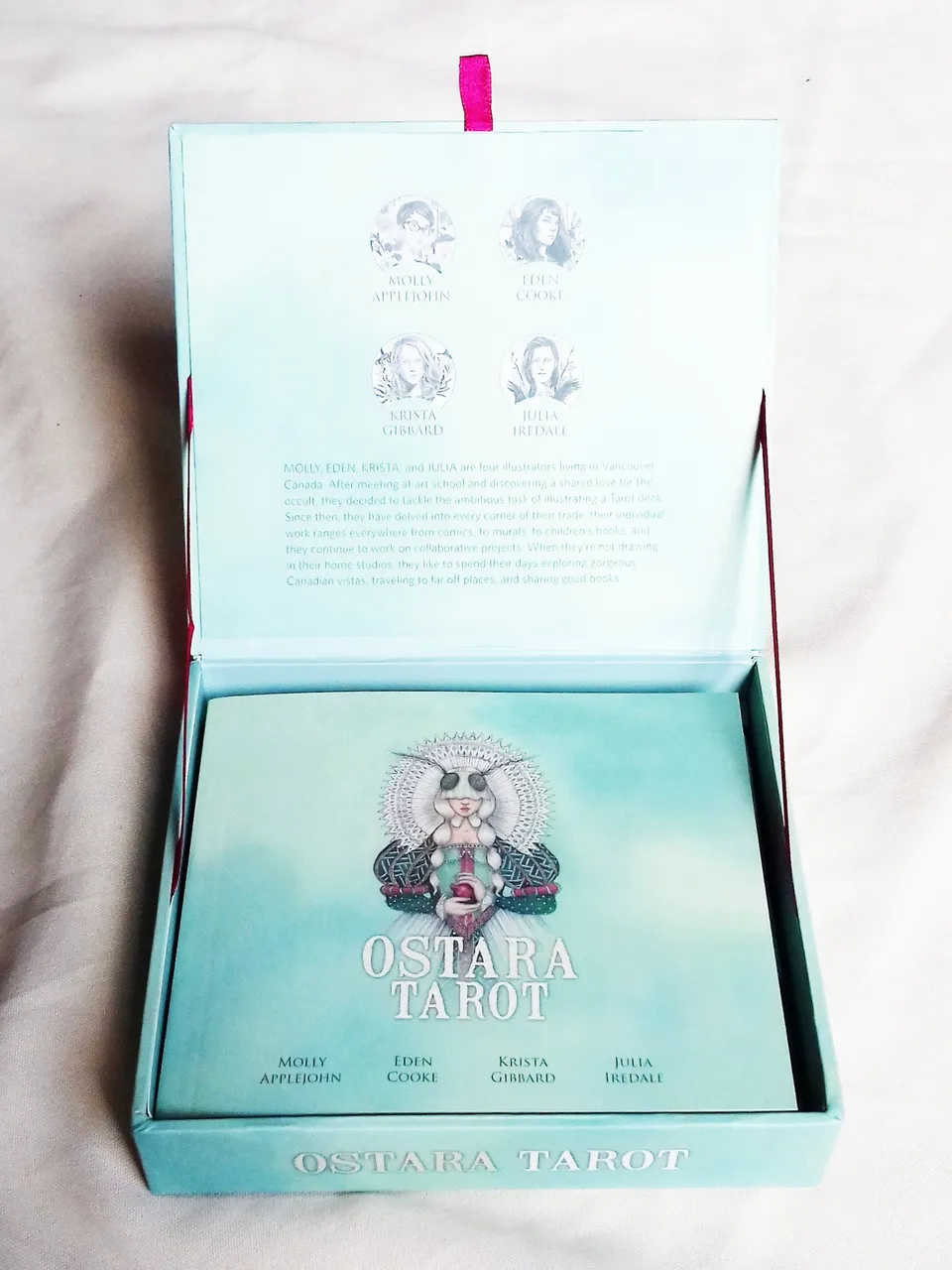
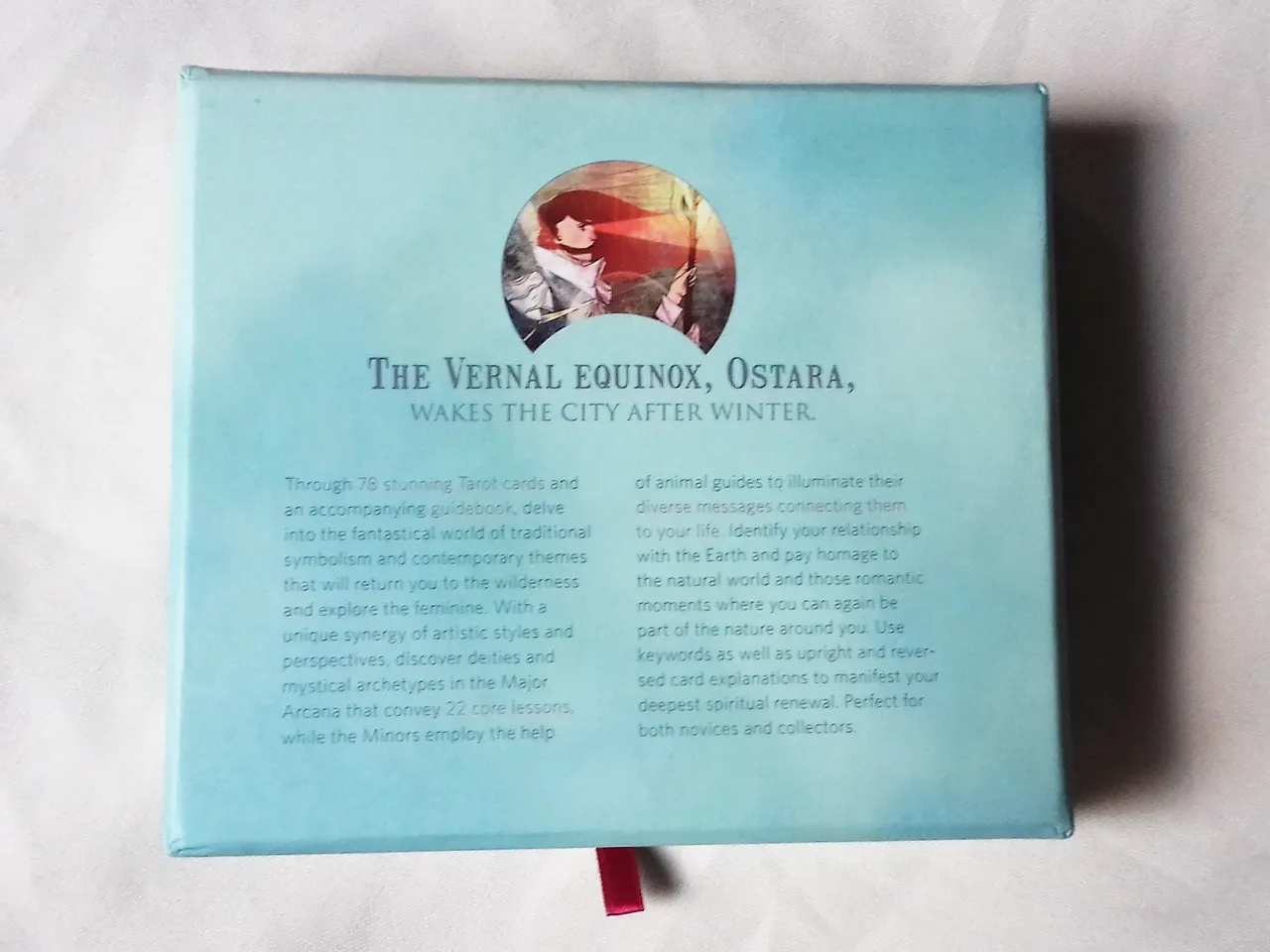
Inside the box are the LWB and the cards. The LWB is BEAUTIFUL, explaining right away the intention of the authors and their concept and giving you indepth information about the deck, card by card, giving keywords and meanings for each card and their reversed meanings, and depicting the card in question in full color; dedicating two pages for the Major Arcana (one for the information and one for the depiction of the card) and one for each of the Minors (showing the info and the depiction). The last few pages give more detailed bits about each of the artists’ careers and projects, as well as their websites and a dedication in the last page.
Dentro de la caja están el PLB y las cartas. El PLB es HERMOSO, explicando inmediatamente las intenciones de las autoras y sus conceptos, así como dando información detallada sobre el mazo, carta por carta, con palabras claves y significados para cada una tanto al derecho como invertida, junto a una ilustración a todo color de la carta en cuestión; dedicando dos paginas para cada Arcano Mayor (una para la información y la otra para la ilustración del mismo) y una para cada Arcano Menor (incluyendo en esta la información y la imagen). Las últimas pocas paginas dan detalles por separado de las carreras y emprendimientos de las artistas así como sus sitios web, y la ultima pagina es una dedicatoria a sus seres queridos.
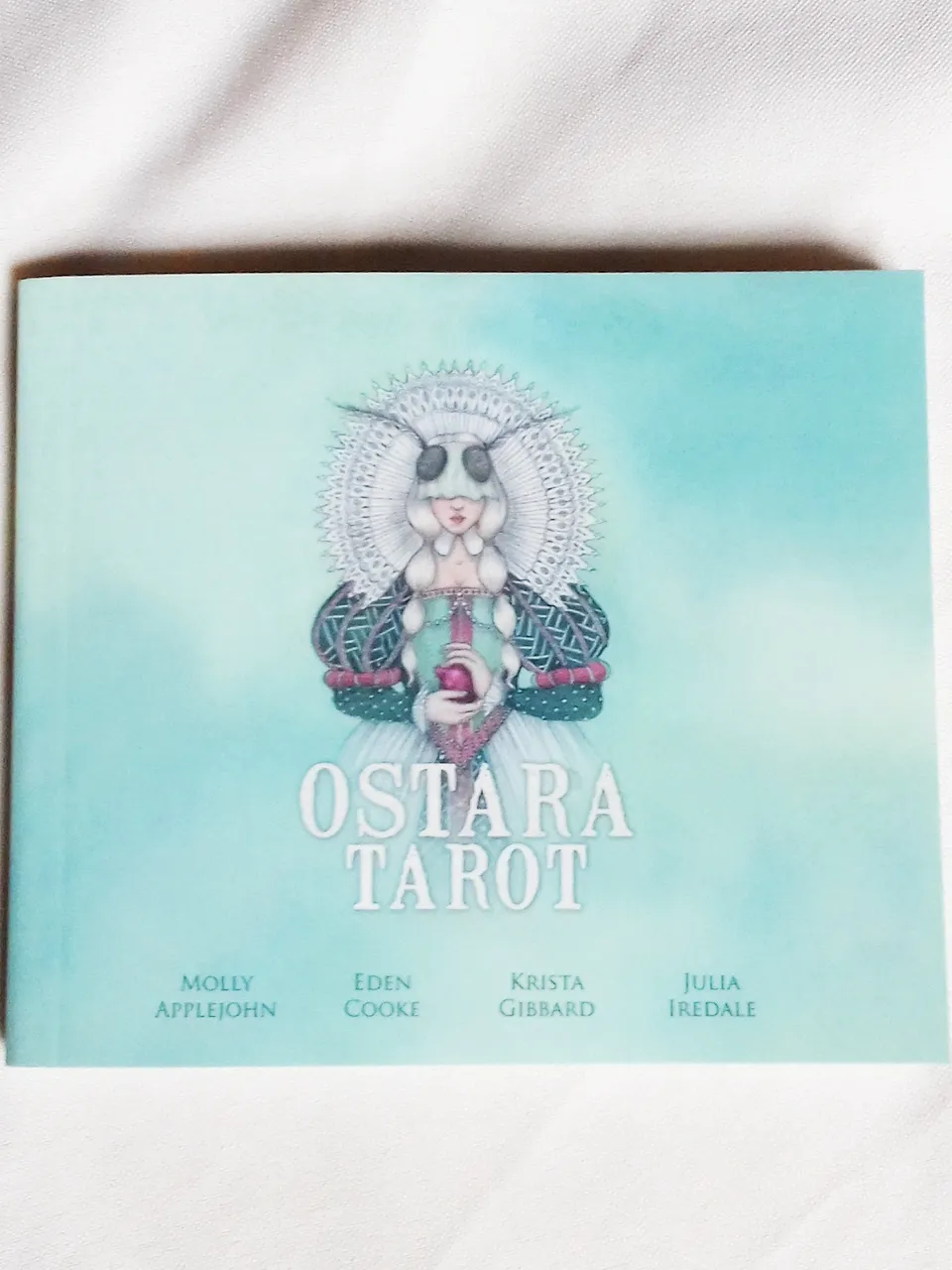
As for the cards, I can’t stress this enough: THEY ARE GORGEOUS. They are divided in two stacks resting right under the LWB, with a small plastic band around each keeping them together. Taking them out and putting them together to make the full deck, you can notice the borders of the deck are all lined to have a silvery, reflective effect.
En cuanto a las cartas, no puedo hacer suficiente énfasis sobre esto: SON HERMOSAS. Están divididas en la caja en dos montoncitos justo debajo del PLB, con una bandita plástica a su alrededor para mantenerlas juntas. Al sacarlas y ponerlas juntas para ver el mazo completo, se nota que estas tienen los bordes hechos con un acabado plateado y reflejante, lo cual es un toque encantador.
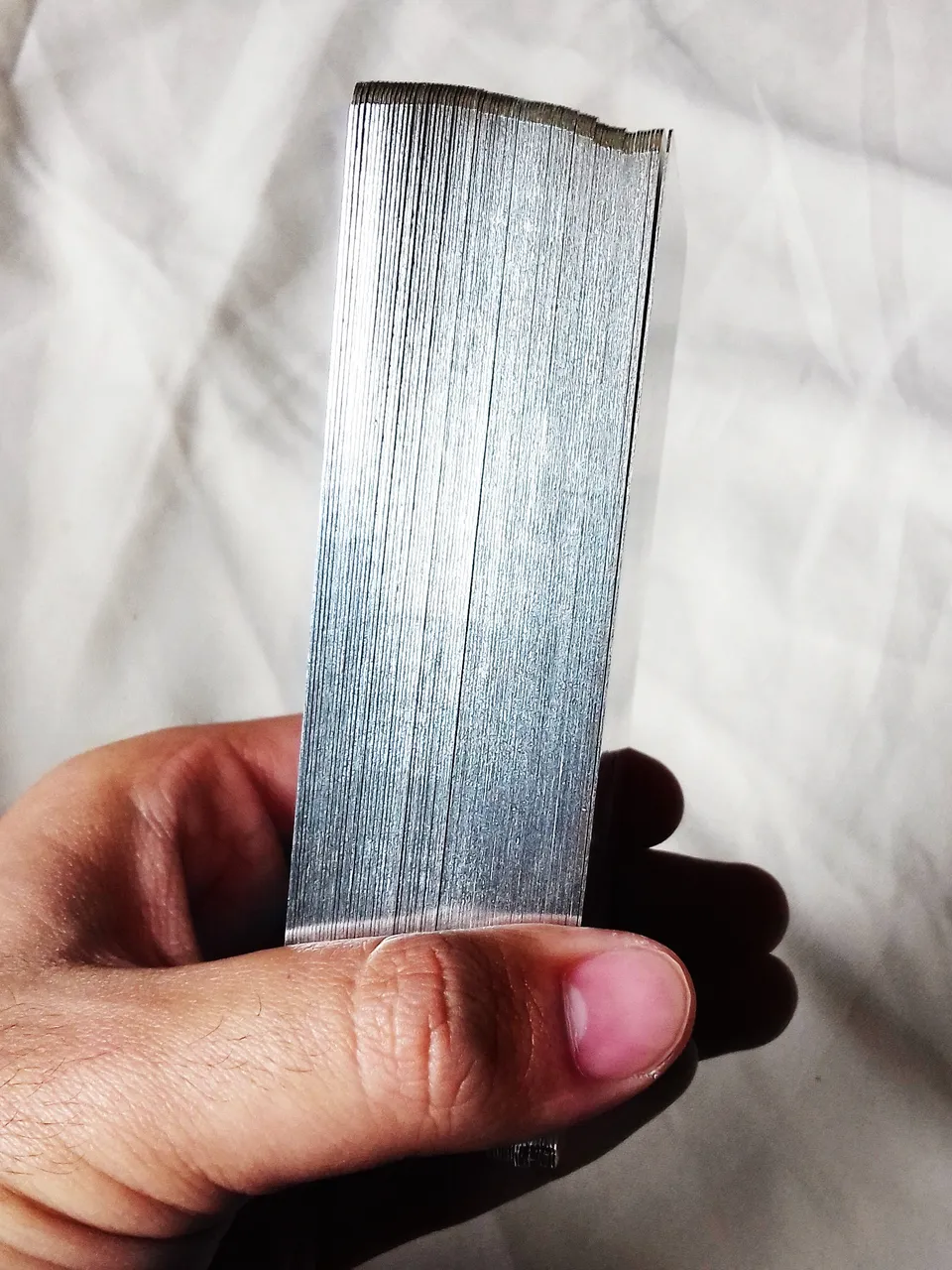
The back of each card is the same misty, cloudy mix of greens tones, with an art deco-style frame surrounding four crescent moon figures and two bird skulls, with flowers sprouting from them: life coming from (and nourishing) from the dead, the return of Spring after Winter. The design is reversible, which makes it hard to tell in which position the card itself is; which is useful for those who read using inverted cards.
La parte de atrás de cada carta tiene un fondo de esa misma nube de tonos verdes, con un marco de estilo art deco rodeando cuatro figures de luna creciente y dos cráneos de aves con flores naciendo de estos: vida naciendo de (y nutriéndose de) los muertos, el retorno de la Primavera tras el Invierno. Este diseño es reversible, lo que evita saber en que posición esta la carta como tal, si al derecho o invertida (útil para quienes lean las cartas invertidas).
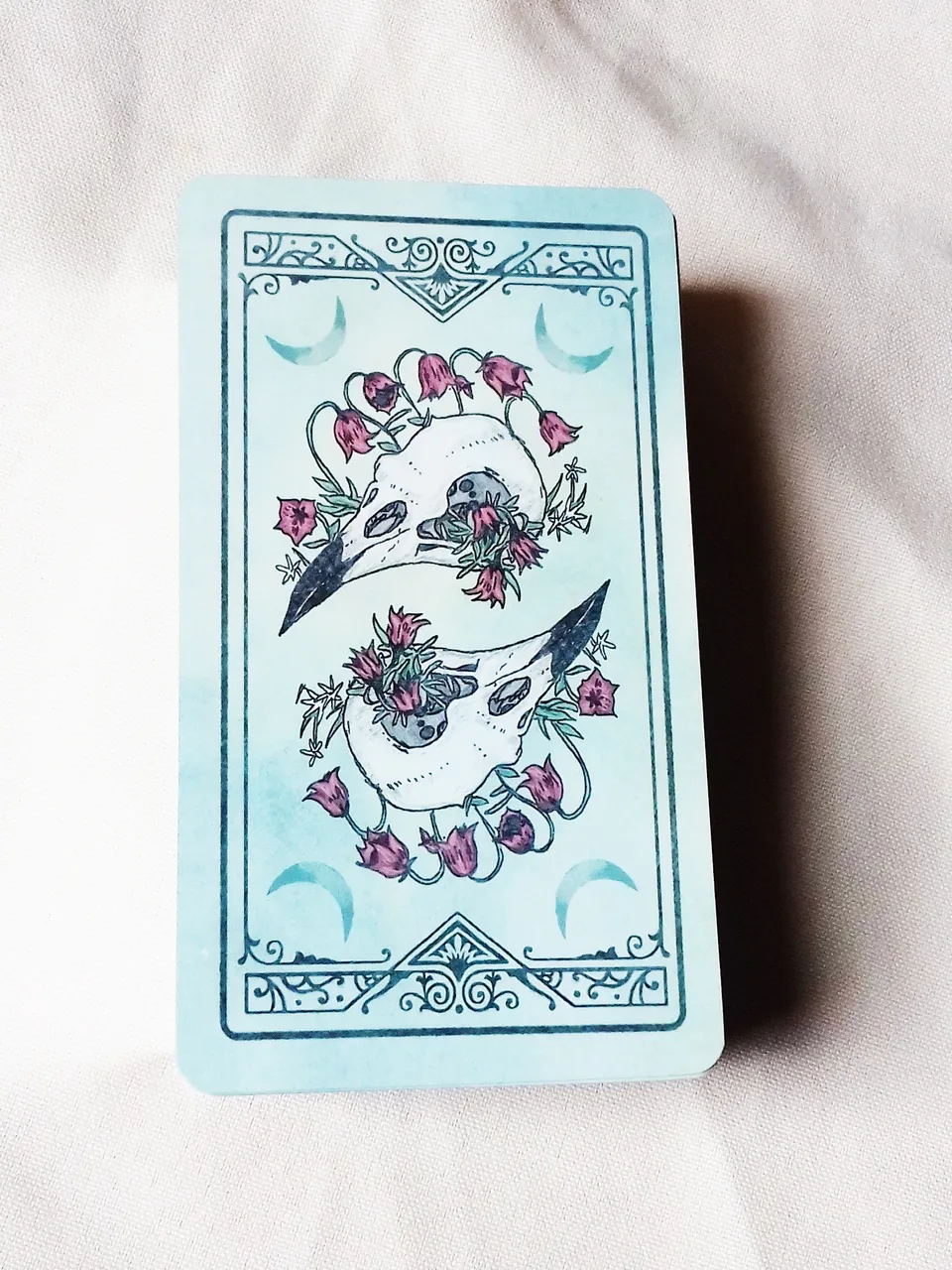
Now, there is much more I want to say about this deck, but I think I’ll finish off here for now. Stay tuned for the next part of this little showcase =3
Ahora bien, hay mucho mas que me gustaría decir sobre este mazo, pero creo que terminare aquí por ahora. Estén atentos para la siguiente parte de esta pequeña reseña =3